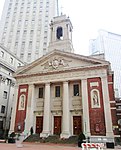Chatham Garden Theatre
1823 establishments in New York (state)1832 disestablishments in New York (state)19th century in New York CityCommercial buildings completed in 1824Cultural history of New York City ... and 3 more
Demolished buildings and structures in ManhattanDemolished theatres in New York CityFormer theatres in Manhattan

The Chatham Garden Theatre or Chatham Theatre was a playhouse in the Chatham Gardens of New York City. It was located on the north side of Chatham Street on Park Row between Pearl and Duane streets in lower Manhattan. The grounds ran through to Augustus Street. The Chatham Garden Theatre was the first major competition to the high-class Park Theatre, though in its later years it sank to the bottom of New York's stratified theatrical order, below even the Bowery Theatre. The Chatham Garden was converted to the Free Presbyterian Chatham Street Chapel in 1832.
Excerpt from the Wikipedia article Chatham Garden Theatre (License: CC BY-SA 3.0, Authors, Images).Chatham Garden Theatre
St. Andrews Plaza, New York Manhattan
Geographical coordinates (GPS) Address Nearby Places Show on map
Geographical coordinates (GPS)
| Latitude | Longitude |
|---|---|
| N 40.713 ° | E -74.003 ° |
Address
Chambers Street (J,Z)
St. Andrews Plaza
10278 New York, Manhattan
New York, United States
Open on Google Maps











